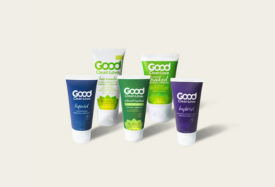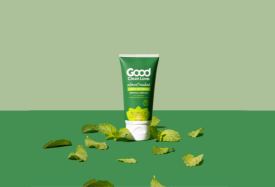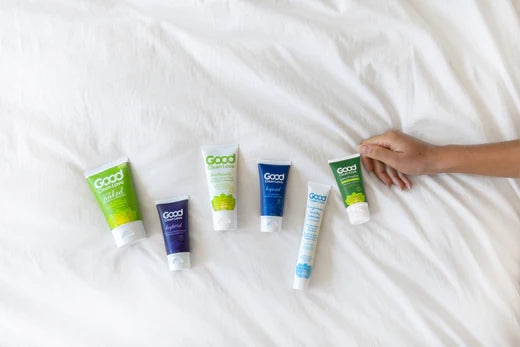Nearly half (44%) of people with vulvas have experienced vaginal dryness, leading to painful or uncomfortable sex. When dryness is an issue, a quality lubricant can be a lifesaver. Lubricants are a great way to increase pleasure and comfort during intimacy. But all lubricants are not alike.
A savvy lube shopper understands that choosing the right lubricant goes far beyond sexy advertising, a pretty box, or a low price. A lubricant’s base formula, how it supports natural vaginal pH levels, and how it supports your natural moisture are things you definitely want to be educated about. (Pro Tip! Get to know the word osmolality.)
Shop Smarter & Feel Better
Lubes can help create a more comfortable and enjoyable intimate experience by reducing uncomfortable friction that results from dryness. But there are so many different lubricants to choose from. How can you know which one is best for you and your vaginal health?
Many of the lubricants you’ll see on shelves at your local store or sold online are not formulated to support the sensitivity of the vaginal ecosystem. That ecosystem can be easily disrupted, so it’s crucial to ensure you are buying a lube that will work with, not against you. The right lubricant can enhance your sexual experiences and provides the added benefit of supporting your vaginal ecosystem. The wrong lubricant might be incompatible with the vaginal microbiome and may result in discomfort such as burning, pain, or itching. The key is to know what makes a good and reliable personal lubricant.

There are a variety of lubricant options to choose from, including silicone-based, oil-based, water-based, and even hybrids. Lubricants with a water-based formulation have many added benefits. Water-based lubes are often a better choice for those with sensitive skin or issues with irritation. They are compatible with toys, safe to use with latex condoms, and clean up easily. Oil-based and silicone-based lubricants, on the other hand, may be difficult to wash off your skin and your sheets.
Three critical factors to consider when purchasing a water-based lubricant are the base ingredient, pH balance, and lubricant osmolality. We will break down exactly what each of these is and why they are essential for vaginal health.
The Importance of Base Ingredients
There are three main base ingredients options in water-based lube. The first is hydroxyethylcellulose, a plant-based ingredient derived from cellulose. Cellulose is a major component of the cell walls of green plants. Hydroxyethylcellulose gives the lube a slippery quality and aids in thickening the product. This ingredient is also proven to be hypoallergenic, which makes it ideal for those ultra-sensitive to other lubricants or who have allergic reactions to aloe products. BioNude™ Ultra Sensitive Personal Lubricant is formulated with hydroxyethylcellulose and is also pH-balanced to help support the vaginal ecosystem.

Another common base ingredient is aloe vera, a natural option that has been historically used for skin care. It is known for its soothing and moisturizing properties and is most commonly known for treating sunburn. Including aloe as a base ingredient can create a product that effectively mimics natural vaginal moisture, such as Almost Naked® Organic Personal Lubricant. This is our bestseller and is also certified organic.
The third base ingredient you’ll find in water-based lubricants is any combination of propylene glycol or other petroleum-based chemicals, parabens, and synthetic glycerin. Unfortunately, these individual ingredients can increase the chances you’ll experience side effects such as burning and itching. In general, water-based lubricants with these ingredients are not recommended as they can adversely affect sensitive genital tissues.
Why the pH of Personal Lubricant Matters
A quality lubricant should help maintain the pH of the vagina. Why is this important? The optimal vaginal pH falls on the acidic side of the pH scale, between 3.8 and 4.5. The pH of the vagina is acidic to protect the area from unhealthy bacteria and prevent yeast from multiplying quickly. Using products that help sustain a healthy vaginal pH is key to maintaining optimal vaginal health and preventing discomfort.
Using lubricants with a high pH can throw the vaginal ecosystem off balance, making it harder for the vagina to fight against harmful bacteria. A pH imbalance in the vagina often manifests as abnormal odor or unusual discharge, and it invites an increased risk of infection. This is why it’s so important to use a pH-balanced lubricant. We recommend Almost Naked® Organic Personal Lubricant, which is right on target with a pH rating of about 4.2. Additionally, Almost Naked lubricant uses Bio-Match technology to maintain a healthy vaginal ecosystem and reinforce the protective actions of healthy vaginal secretions by matching its optimal pH and salt balance.
What Is Osmolality and Why Is It Important?
Personal lubricants should enhance pleasure during intimacy and have a positive impact on your sexual health after use. Still, many women experience adverse effects such as burning or itching as a result of using lubricants, effects that could be due to the osmolality of the specific lubricant used.
There’s that word we mentioned before. But what exactly is osmolality?

A lubricant’s osmolality is a numeric value that indicates how concentrated the molecules are compared to the area with which it is interacting – in this case, the protective tissues of the vagina. A lubricant’s osmolality is important to maintaining vaginal health because the layers of tissue and natural mucus of the body constantly attempt to maintain a healthy balance when they encounter a substance, such as a lubricant. A lubricant with an osmolality rating that is highly compatible with sensitive vaginal tissues helps support the vital protective role of those tissues. The opposite is true when a lubricant’s osmolality differs significantly from the healthy vaginal environment. And when disruption occurs, there is an increased risk of irritation, pain, development of infections, and greater susceptibility to STIs or STDs.
There are three degrees of osmolality found in personal lubricants:
Hyper-osmolality
This is when a lubricant has a higher osmolality than the vaginal tissue. In this case, the vaginal tissue has to release its moisture in an attempt to maintain protective stability. The lubricant will temporarily create a slippery environment but a hyperosmolar lube will ultimately dry out the vaginal tissue instead of moisturizing it. The result can include an increased risk of cell damage and painful abrasions. It’s been scientifically proven that hyperosmolar lubricants can be associated with increased risks of vaginal infections such as bacterial vaginosis (BV). Unfortunately, lubricants that are hyperosmolar are relatively prominent on the market.
Hypo-osmolality
A hypo-osmolar lubricant has the opposite effect. This type of osmolality indicates that a lubricant has a lower osmolarity than the vaginal tissue. Using this type of lubricant causes the cells in the vaginal tissue to pull excess water out of the lubricant, leaving the cells overhydrated and at risk of bursting.
Iso-osmolality
This is the osmolality level of an ideal lubricant. An iso-osmotic lube has a hydration level that closely matches the epithelial cells of the vaginal tissue. This product, when introduced into the vagina during penetrative sex, won’t over-or under-load the epithelial cells with water. The vaginal lining stays balanced and maintains its natural equilibrium, and there’s little risk of inflammation or infection in the vaginal lining. As an added benefit, iso-osmolar lubricants also prevent the risk that Lactobacilli – the healthy bacteria that stimulates healthy cervical mucus and discourages infection – will be negatively affected.
The chart below shows how closely the osmolality of Almost Naked® Organic Personal Lubricant matches bodily fluids, in comparison to other brands of lubricant.

Wendy Strgar, CEO of Good Clean Love, comments on the importance of osmolality in lubricants: “The most important thing that comes with maintaining vaginal health is not to do any harm. There should be no adding or subtracting to the osmolality. The product you are using either matches or it doesn’t.” Having comfortable sex is important – often critical to a healthy, happy relationship. Still, having comfortable sex that doesn’t result in irritation or damage to sensitive vaginal tissues is the intention you’re really after.
The product you choose to make part of your intimacy warrants careful, well-educated consideration, to ensure it supports the vaginal ecosystem. If a product is contributing to discomfort, that is a sign that it is incompatible with your ecosystem.
“Discomfort in the vagina is the body communicating to you that something is off. If you are feeling discomfort when using a product, it’s your body letting you know that something is wrong,” says Strgar. And she emphasizes the importance of transparency about ingredients and the overall composition of products: “It’s high time we tell the truth about what we are putting in our products. Women deserve to know what they are being given and sold, and they need to be told what is happening in their body.”














